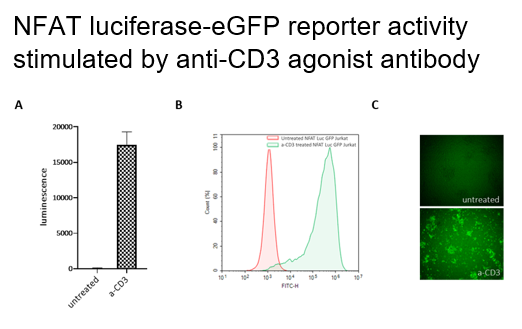NFAT Luciferase-eGFP Reporter Jurkat Cell Line
Recombinant Jurkat T cells expressing both firefly luciferase and enhanced GFP (eGFP) under the control of NFAT response elements located upstream of the minimal TATA promoter. Activation of the NFAT signaling pathway can be monitored by examining either firefly luciferase or eGFP expression.
Interested in screening and profiling inhibitors or activators of NFAT-mediated signaling pathways without the need to purchase and license the cell line? Check out our Cell Signaling Pathway Screening.
Purchase of this cell line is for research purposes only; commercial use requires a separate license. View the full terms and conditions.
| Name | Ordering Information |
| Thaw Medium 2 | BPS Bioscience #60184 |
| Growth Medium 2E | BPS Bioscience #79638 |
The cell line has been screened to confirm the absence of Mycoplasma species.
The Nuclear Factor of Activated T Cells (NFAT) family of transcription factors plays an important role in mediating the immune response. T cell activation through the T cell synapse results in calcium influx, which is required to facilitate actin organization and interactions at the synapse. Increased intracellular calcium levels activate the calcium-sensitive phosphatase Calcineurin, which rapidly dephosphorylates the serine-rich region (SRR) and SP-repeats in NFAT proteins. This results in a conformational change that exposes a nuclear localization signal (NLS) promoting NFAT nuclear translocation and inducing gene expression, including various cytokines (IL-2, IL-3, IL-4, and TNF-alpha). Members of the NFAT family have been found in many tissue types, including the heart, skeletal muscle, and brain. These transcription factors are known to be highly involved in the pathological processes of inflammation and cancer. This reporter cell line is designed to monitor T cell activation or inhibition through various checkpoint inhibitors. It can be used as a control or parental cell line to co-express various immune checkpoint inhibitors, such as PD1.


